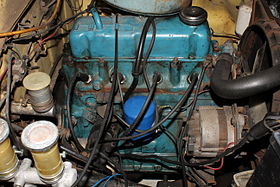This article needs additional citations for verification. (March 2012) |
| J engine | |
|---|---|
 | |
| Overview | |
| Manufacturer | Nissan |
| Production | 1965–1982 |
| Layout | |
| Configuration | Inline-4, Inline-6 |
| Displacement |
|
| Cylinder bore |
|
| Piston stroke |
|
| Cylinder block material | Cast iron |
| Cylinder head material | Cast iron |
| Valvetrain | OHV |
| Combustion | |
| Fuel system | Carburetor |
| Fuel type | Gasoline |
| Cooling system | Water-cooled |
| Output | |
| Power output | 68–140 PS (50–103 kW) |
| Chronology | |
| Successor | Nissan L engine |
The Nissan J series are straight-4 and straight-6 gasoline internal combustion engines produced by Nissan from the 1960s through the 1980s. It is similar to the BMC B-Series engine that was built in Japan under licence as the Nissan 1H before being de-stroked to become the 1.0 L Nissan C[1][2] and 1.2 L Nissan E engines,[3] but wasn't a direct copy.[4]
A version of Volkswagen's two-litre, "JL" five-cylinder engine was used in the (Nissan) Volkswagen Santana with 110–140 PS (81–103 kW) and was called the "J" engine by Nissan, but it shares nothing with the original J20 even though it is also a two-liter engine.
- ^ Halberstam, David (2012). The Reckoning. New York: Open Road Integrated Media. ISBN 978-1453286104.
- ^ Britain & Japan : biographical portraits. Vol. VI. Folkestone, UK: Global Oriental Ltd. 2007. pp. 104–105. ISBN 978-9004217850.
- ^ "Tech Wiki - Datsun History : Datsun 1200 Club". datsun1200.com.
- ^ Bent, Alan. "Austin A40 and A50". EarlyDatsun.com. Archived from the original on 8 February 2015.